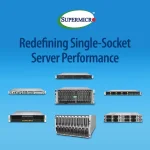Super Micro Computer just released new servers that need only one processor instead of two. These servers can handle the same jobs that used to require dual-processor setups. Companies can save money when they buy these single-socket systems. They also spend less on electricity and cooling. Plus, these servers take up less space in data centers compared to older models with outdated chips.
Charles Liang, who runs Supermicro, says we've entered a time when energy-smart single-socket designs work great instead of traditional two-processor servers. Their latest single-socket systems offer twice as many cores as before. The team designed them to maximize speed, network options, and storage flexibility. These new systems support processors that use up to 500 watts of power. You can set them up for many different types of work.
Karin Eibschitz Segal from Intel talked about their partnership with Supermicro to create fast server solutions. Their expanded lineup of single-socket systems uses the newest Intel Xeon 6 processors with P-cores. These chips have more cores, support faster memory, and offer up to 136 PCIe 5.0 lanes. This gives you performance that previously required two sockets.
IDC researcher Kuba Stolarski points out that businesses care about efficiency and cost savings for their equipment. Single-socket servers meet these needs perfectly. They balance performance, ability to grow, and total cost just right for many workloads. These servers work well for edge computing and virtualization. Companies looking to expand efficiently should consider them.
You can set up Supermicro's single-socket servers for many different tasks. These include electronic design, financial services, cloud computing, storage, content delivery, virtualization, AI, networking, and edge computing. Single-socket designs have key advantages over multi-processor systems. Without CPU-to-CPU connections, more of the processor's input-output capacity becomes available for PCIe expansion. This also prevents latency issues related to memory access.
Customers benefit greatly when they deploy single-processor servers. Many cloud and storage jobs that needed two CPUs per system can run just as well or better with one processor. Single-socket servers save money not just on initial purchase but also through reduced power use. They create less heat, which cuts cooling costs. You need less physical space for your data center infrastructure.
Supermicro offers several product families optimized for single-socket Intel Xeon 6 processors with P-Cores. Their SuperBlade provides maximum performance with lower total cost for stock exchanges, AI tasks, data analysis, cloud computing, and enterprise workloads. These systems come in air-cooled or liquid-cooled options. They fit up to 20 servers in an 8U enclosure or 10 servers in a 6U enclosure.
Hyper servers deliver flagship performance for cloud workloads. They offer storage and input-output flexibility to fit many application needs. The CloudDC platform follows open standards for data centers. WIO systems feature flexible input-output setups at reasonable prices. Top-loading Storage maximizes density with 60 or 90 drive bays. GrandTwin focuses on single-processor performance with easy service access. Edge systems pack processing power into compact shapes for remote locations.
Charles Liang, who runs Supermicro, says we've entered a time when energy-smart single-socket designs work great instead of traditional two-processor servers. Their latest single-socket systems offer twice as many cores as before. The team designed them to maximize speed, network options, and storage flexibility. These new systems support processors that use up to 500 watts of power. You can set them up for many different types of work.
Karin Eibschitz Segal from Intel talked about their partnership with Supermicro to create fast server solutions. Their expanded lineup of single-socket systems uses the newest Intel Xeon 6 processors with P-cores. These chips have more cores, support faster memory, and offer up to 136 PCIe 5.0 lanes. This gives you performance that previously required two sockets.
IDC researcher Kuba Stolarski points out that businesses care about efficiency and cost savings for their equipment. Single-socket servers meet these needs perfectly. They balance performance, ability to grow, and total cost just right for many workloads. These servers work well for edge computing and virtualization. Companies looking to expand efficiently should consider them.
You can set up Supermicro's single-socket servers for many different tasks. These include electronic design, financial services, cloud computing, storage, content delivery, virtualization, AI, networking, and edge computing. Single-socket designs have key advantages over multi-processor systems. Without CPU-to-CPU connections, more of the processor's input-output capacity becomes available for PCIe expansion. This also prevents latency issues related to memory access.
Customers benefit greatly when they deploy single-processor servers. Many cloud and storage jobs that needed two CPUs per system can run just as well or better with one processor. Single-socket servers save money not just on initial purchase but also through reduced power use. They create less heat, which cuts cooling costs. You need less physical space for your data center infrastructure.
Supermicro offers several product families optimized for single-socket Intel Xeon 6 processors with P-Cores. Their SuperBlade provides maximum performance with lower total cost for stock exchanges, AI tasks, data analysis, cloud computing, and enterprise workloads. These systems come in air-cooled or liquid-cooled options. They fit up to 20 servers in an 8U enclosure or 10 servers in a 6U enclosure.
Hyper servers deliver flagship performance for cloud workloads. They offer storage and input-output flexibility to fit many application needs. The CloudDC platform follows open standards for data centers. WIO systems feature flexible input-output setups at reasonable prices. Top-loading Storage maximizes density with 60 or 90 drive bays. GrandTwin focuses on single-processor performance with easy service access. Edge systems pack processing power into compact shapes for remote locations.












